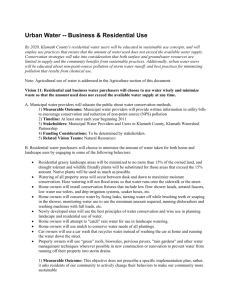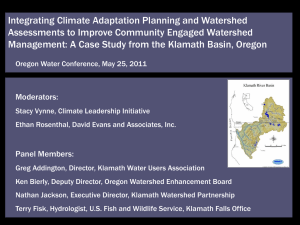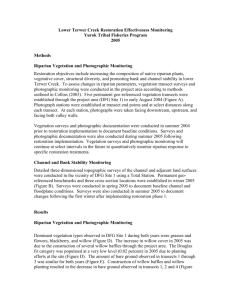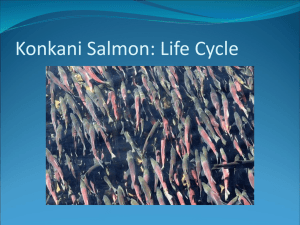PLEASE DO NOT RESTORE MY KLAMATH RIVER by Glen Briggs
advertisement
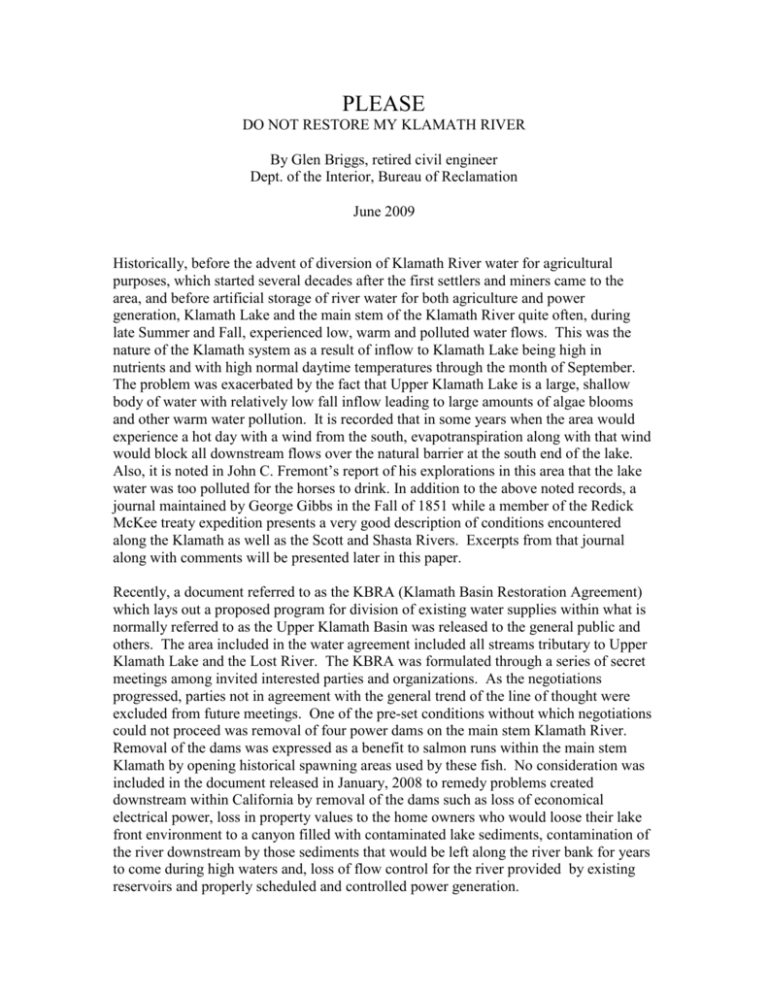
PLEASE DO NOT RESTORE MY KLAMATH RIVER By Glen Briggs, retired civil engineer Dept. of the Interior, Bureau of Reclamation June 2009 Historically, before the advent of diversion of Klamath River water for agricultural purposes, which started several decades after the first settlers and miners came to the area, and before artificial storage of river water for both agriculture and power generation, Klamath Lake and the main stem of the Klamath River quite often, during late Summer and Fall, experienced low, warm and polluted water flows. This was the nature of the Klamath system as a result of inflow to Klamath Lake being high in nutrients and with high normal daytime temperatures through the month of September. The problem was exacerbated by the fact that Upper Klamath Lake is a large, shallow body of water with relatively low fall inflow leading to large amounts of algae blooms and other warm water pollution. It is recorded that in some years when the area would experience a hot day with a wind from the south, evapotranspiration along with that wind would block all downstream flows over the natural barrier at the south end of the lake. Also, it is noted in John C. Fremont’s report of his explorations in this area that the lake water was too polluted for the horses to drink. In addition to the above noted records, a journal maintained by George Gibbs in the Fall of 1851 while a member of the Redick McKee treaty expedition presents a very good description of conditions encountered along the Klamath as well as the Scott and Shasta Rivers. Excerpts from that journal along with comments will be presented later in this paper. Recently, a document referred to as the KBRA (Klamath Basin Restoration Agreement) which lays out a proposed program for division of existing water supplies within what is normally referred to as the Upper Klamath Basin was released to the general public and others. The area included in the water agreement included all streams tributary to Upper Klamath Lake and the Lost River. The KBRA was formulated through a series of secret meetings among invited interested parties and organizations. As the negotiations progressed, parties not in agreement with the general trend of the line of thought were excluded from future meetings. One of the pre-set conditions without which negotiations could not proceed was removal of four power dams on the main stem Klamath River. Removal of the dams was expressed as a benefit to salmon runs within the main stem Klamath by opening historical spawning areas used by these fish. No consideration was included in the document released in January, 2008 to remedy problems created downstream within California by removal of the dams such as loss of economical electrical power, loss in property values to the home owners who would loose their lake front environment to a canyon filled with contaminated lake sediments, contamination of the river downstream by those sediments that would be left along the river bank for years to come during high waters and, loss of flow control for the river provided by existing reservoirs and properly scheduled and controlled power generation. At this point, a little background leading up to existing problems seems appropriate in order to understand the mind set leading up to KBRA negotiations. The background expressed here is the conclusion arrived at over time by a reasonably intelligent individual keeping appraised of current news items. The Upper Klamath Basin as described above is located in a semi-arid region with limited water supply. Much of the area is of volcanic origin. Upper Klamath Lake is a large, shallow lake fed by water sources high in nutrients and experiences high water temperatures during late summer and fall. Historically, high evaporation rates reduced downstream flows to very low values, and, at times were actually cut off intermittently. Development of the Klamath Basin Irrigation Project early in the 20th century provided storage of winter flows to be used for summer irrigation of Project lands. Later, development of the power potential created by storage of winter flows was pursued by private interests. Water supplies for agriculture, while never over abundant, would become critical during periods of drought. Later, after the project had been operating for quite a number of years, environmental interests began to believe that the river system was being impaired by water diverted for agriculture and by the existence of power dams. Pressure was put on the power company to remove the dams and then when re-licensing became necessary, that pressure was increased many fold. Meanwhile, court action against agricultural interests increased leading to a court ordered cut-off of irrigation water in the year 2001 which was financially devastating to many Project land owners. Thus when the secret negotiations leading up to the KBRA promised relief from court ordered water stoppages at the hands of environmental interests in exchange for support in achieving dam removal, many Project land owners were willing to sign on (blackmailed). In spite of numerous problems certain to take place on the Klamath main stem, Dam opponents list the only benefit to be restoration of the river so that hypothetical large salmon runs can return. These opponents are either so brainwashed into the idea that restoration of any river system will lead to good things or they are so dead set against any dam that they do not care about the consequences. In the paragraphs below I will attempt to paint a picture, mostly based on descriptions given by George Gibbs, but also enhanced by a lifetime of contact with the Klamath River and knowledge passed on by three previous generations of Klamath River residents. The Journal used herein is titled “GEORGE GIBBS’JOURNAL OF REDICK MCKEE’S EXPEDITION THROUGH NORTHWESTERN CALIFORNIA IN 1851” Edited and with annotations by Robert F. Heizer. ARCHEOLOGICAL RESEARCH FACILITY, Department of Anthropology, University of California, Berkeley. 1972. As explained by Mr. Heizer, George Gibbs was a well educated man with a law degree from Harvard University. After practicing law for a while, he came west to Oregon and subsequently learned some of the language of Indian tribes along the Columbia River. He came to California in time to sign on as interpreter for the Redick McKee Treaty expedition. On Saturday, September 27th the expedition reached the vicinity of the junction of the Klamath and Trinity rivers and then returned to this vicinity on or about November 13th after having traveled along the Klamath main stem to Scott River, up Scott River to Scott Valley then exploring the Shasta Valley. Along the way, Mr. Gibbs recorded his observations concerning local Indian tribes, the River and the surrounding area. It must be remembered that the first mining parties to visit the Klamath took place in 1850, 2 the year prior to the McKee expedition and, in view of the difficult terrain, no large scale mining operations had been started. On September 29th, while near the junction of the Trinity and Klamath Rivers about 35 miles upstream from the mouth of the Klamath, Mr. Gibbs gave a general description of the two rivers. In part he said “Like the Klamath, the Trinity runs during it’s whole length through mountains; It is in size about half that of the Klamath, and it’s waters, likewise rapid, are of transcendent purity; contrasting with those of the latter stream which never lose the taint of their origin. The other principal branches of the Klamath, Salmon, Scott’s, and Shaste rivers, will be spoken of hereafter.” Note: It is significant that Mr. Gibbs should speak of the waters of the Klamath as tainted while this far downstream from it’s source. Besides the major tributaries mentioned above, approximately 100 tributaries of lesser sizes enter the Klamath above his location. Some of these such as Indian Creek, Elk Creek, Camp Creek among others contribute a significant amount of cold, clear water into the Klamath even during Fall months. “Thursday, Oct. 9th. The business of the treaty being concluded, the camp broke up today, -- A couple miles above the forks, we reached the Hai-am-mu village, -- At this village there was a large fish-dam: a work exhibiting an extraordinary degree of both enterprise and skill. -- The whole dam was faced with twigs, carefully peeled, and placed so close together as to prevent the fish from passing up. -- The labor of constructing this work must, with the few and insufficient tools of the Indians, have been immense. -Slight scaffolds were built out below it,” ( at an opening in the dam) “from which the fish were taken in scoop-nets; -- Similar dams to this exist on the Klamath, a few miles below the forks, and about fifteen above this one: and there is another upon the Trinity, -- They form a frequent cause of quarrel among the bands inhabiting different parts of the rivers.- Almost all the fish taken in the autumn have a diseased appearance; the skin being discolored in large blotches.” Annotation No. 53 by Heizer: “ Dams or weirs which completely closed the stream to fish ascending to spawn could have been effective in preventing salmon from proceeding further upstream than the dam and thus denying others from partaking in the run. The Kepel dam on Klamath River (Kroeber, Handbook, pp. 58-60) was torn down after ten days of operation, not because it was inefficient, but because tribes upstream (Hupa, Karok, and Shasta) would insist on their share of the salmon run.” Note: Above statements raise questions about the overall size of fall salmon runs in the mid-1800’s. If the runs were as large as some presently speculate, there would be no way that the Indian, using dip net and spears, could have caught 3 enough of the migrating salmon to impact upstream needs. Also, the fact that the salmon were diseased looking after only coming this far up the river, low river flows along with diseases were already taking it’s toll. A large salmon die-off in the mid-Klamath in about 1915 has been documented by the Ca. Div. of Fish and Game as having been caused by a gill disease endemic to the Klamath River. Tuesday, Oct. 14th. Speaking of native dogs owned by the Indians, Gibbs states: “Unfortunately salmon blood does not kill them, as it does dogs of a more generous breed.” Note: Salmon poisoning of dogs is another disease endemic to the warm waters of the Klamath. Wednesday, Oct. 15th.—“Here we encamped at the mouth of Clear Creek – These Indians complained of hunger, and seemed really destitute.” Monday, Oct. 30th. – “In camping on the Klamath, it is necessary to seek the neighborhood of the brooks, especially at this season; as the water, never pure, is now offensive from the number of dead salmon.” Annotation No. 69 by Heizer: “There may be some connection between the Yurok idea that the waters of the Klamath are “poisonous” (Kroeber, Handbook, p. 69), and the dead salmon which, after the spawning run, contaminate it,” Note: During my younger years on the Klamath, 1931 to 1940, I never personally observed dead salmon lying along the banks while my mother, born in 1909, told of being directed, as a young girl, by her grandfather to get sharp sticks to throw the dead fish back into the river. However, I was constantly warned to never swallow Klamath River water. By the time of my younger years, some of the power dams were in place which improved late summer and Fall flow conditions. Tuesday, Oct. 21st. – Speaking of the Scott River: “while in the summer and fall it is fordable almost anywhere.” Monday, Oct. 27th. While exploring the Shasta Valley – “The river itself, wandering through arid plains, becomes tepid and unfit for use,” Wednesday, Nov. 12th. On the return trip downstream the party camped overnight near the mouth of the Salmon River. “The salmon fishing was still going on; but the greater part of the fish exhibited an unhealthy appearance. 4 Removal of power dams from the main stem of the Klamath River will not restore the river to a condition more favorable to human or fisheries habitation as shown by the above notes. Loss of storage used to generate electrical power during times when natural flow would be inadequate will likely throw the river back to a diseased condition of low, warm,polutted water flows. Also, the Klamath is not referred to as an upside down river just by chance. The fact that the river water is warm and polluted at it’s source and improves the further downstream you go is not a normal situation and without the help of colder water stored in the reservoirs, this situation will be exacerbated. Start of the fall salmon run quite often is delayed because of inadequate flows over the bar at the river mouth. Salmon collect in the ocean near the mouth waiting for adequate, cold water. If a coastal storm opens the bar before flows from the upper river have cooled and increased, the salmon will be in real trouble before reaching their destination. There is no known documentation from the period of early exploration and settlement of the upper Klamath Basin that indicates the existence of spawning salmon above Upper Klamath Lake. The existence of fish bones found at village sites has led to the belief that they were caught near those locations when, in fact, they were most likely caught downstream and carried to the village. If, by chance, a few salmon did manage to migrate into the Upper Basin on exceptional water years does not mean that a permanent run could be established that far upstream following removal of the dams. It is true that these power dams have no storage space dedicated to flood control; however, just the fact that they are there provides a certain degree of protection. The dam operators must maintain storage necessary for protection of the structures by evaluating potential inflow and by making releases ahead of unusual events. A flood generated in the upper basin capable of causing significant damage downstream of the dams is a definite possibility. During the early spring months of 2008 all of the players were in position to cause a disastrous flood originating in the upper basin except for the kicker. That kicker being a warm rain which would have melted the several inch blanket of snow spread over the large upper basin area. Such a condition existed in the Columbia Basin area of Eastern Washington in 1949 and the kicker did show up. Look up the record of flows in Crab Creek. For the sake of us all that call the Klamath home, including the Coho salmon who did not reside in the mid to upper Klamath prior to construction of dams, PLEASE do not restore the Klamath River. 5 By: Glen Briggs, Seiad Valley, CA. B.S., Civil Engineering Oregon State University 1960 Civil Engineer, retired Dept. of Interior Bureau of Reclamation 1960 to 1987 6

